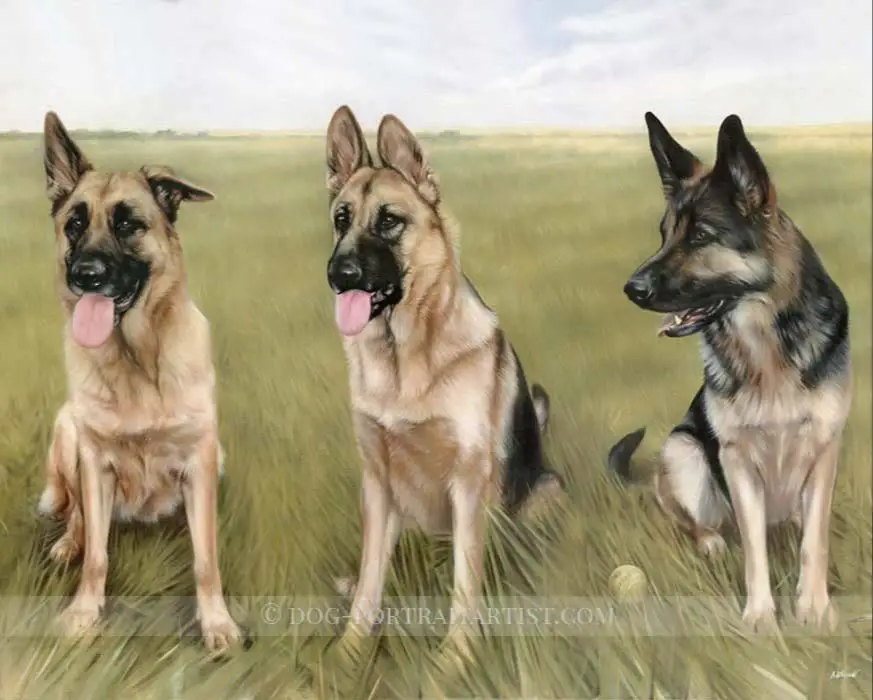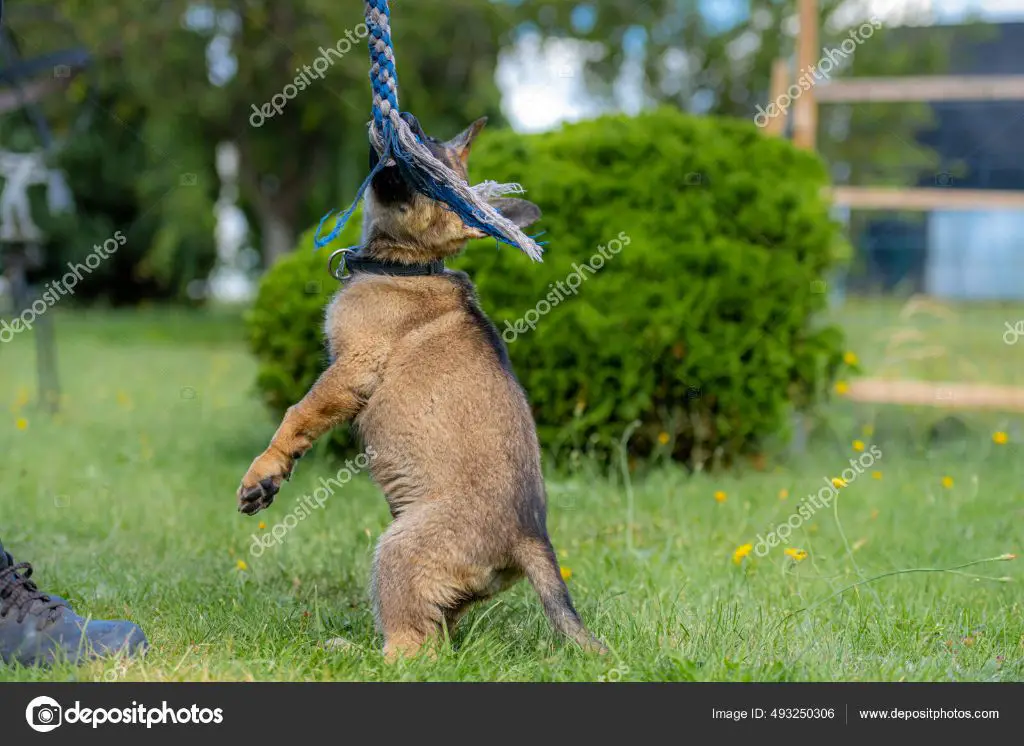Introduction
The German Shepherd dog breed has a relatively short but well-documented history. The breed originated in Germany in 1899 when Captain Max von Stephanitz, an ex-cavalry captain, sought to create the ideal German herding dog. He was instrumental in establishing the Verein für Deutsche Schäferhunde or SV, the first club devoted to the German Shepherd Dog. Von Stephanitz focused his breeding efforts on intelligence, temperament, and working ability rather than just appearance.
The German Shepherd was first exhibited at a dog show in 1882. Over the next few decades, von Stephanitz and other dedicated breeders worked to develop and standardize the breed. They bred dogs with intelligence, loyalty, athleticism, and a willingness to learn. The German Shepherd proved adept at herding, military and police work, search and rescue, and many other roles. Today, it remains one of the most popular dog breeds in the world.
The German Shepherd is a medium to large, agile dog with a noble, wedge-shaped head, erect ears, and a long, sloping back. It has a double-layer coat that can be short, medium or long haired. Coat colors include black and tan, black and red, and solid black. German Shepherds are highly intelligent, active dogs that require regular exercise and training. When properly trained and socialized, they make excellent guard dogs, service dogs, military dogs, police dogs, and loyal family companions.
Appearance
The German Shepherd Dog has a well-balanced, muscular and athletic build. They have a noble body with clean, sturdy limbs and a well-defined head with erect ears. Their size is medium to large, with males standing 24-26 inches at the shoulder and weighing 60-90 pounds. Females stand 22-24 inches and weigh 50-70 pounds (German Shepherd Dog Breed Information).

They have a medium-length double coat that can be straight, wavy or long. Common coat colors include black and tan, black and red, black and silver, black and cream, sable, and all-black. Some long-haired German Shepherds may have an undercoat up to 2 inches long with guard hairs reaching 8 inches or more (German Shepherd Dog History and Characteristics). The long-haired type is recognized as a variety in some clubs but not formally separate from the short-haired type.
Temperament
The German Shepherd’s temperament is characterized by loyalty, obedience, alertness, courage, and
self-confidence (German Shepherd Dog Breed Information & Characteristics). They are intelligent, eager to learn, highly adaptable, and can perform a variety of tasks with excellence. German Shepherds are affectionate with their families and make excellent guard dogs due to their protective nature. However, they need extensive socialization from an early age to curb aggressive tendencies. German Shepherds are high energy dogs and require regular, rigorous exercise and mental stimulation. Without it, they are prone to anxiety, boredom, and destructive behavior. They thrive when given a job to do. Overall, the German Shepherd is an intense, driven, and obedient dog that excels as a working dog but also makes a wonderful family companion if properly trained and exercised.
Types
There are three main types of German Shepherd dogs: working lines, show lines, and pet lines. Each has been bred for different purposes and has distinct differences.
Working lines are bred for traits like intelligence, drive, and ability to work as service dogs, police dogs, or in the military. They tend to be very active dogs with high energy levels. Working line shepherds often exhibit a straighter back and have a more athletic build than other types. According to Pupspal, working line shepherds make excellent guard dogs or competitors in dog sports due to their working drive and athleticism [1].
Show lines are bred for their appearance and to adhere closely to the breed standard defined by kennel clubs. They tend to have a sloped back and feature black and tan or black and red coats. Show line shepherds are often calmer than working lines. However, they still require daily exercise. Show lines excel in conformation shows and companionship roles [2].
Pet lines are a cross between working and show lines. They make great family companions due to their affectionate nature and medium energy level. Pet line shepherds are not suited for intense working roles but enjoy activities like hiking, swimming, and playing fetch.
Working Lines

German Shepherds bred for working lines focus on intelligence, drive, and athleticism for police, military, and service work. These dogs descend from the original herding dogs in Germany and maintain the temperament and abilities for demanding occupations. According to Kennel Club Boarding, “After the war, both America and Germany became highly strict in breeding and training program of the German Shepherd working lines.”
Working lines are bred for their working ability rather than appearance. As Debut Shepherds explains, “The characteristic regal head and shoulders of the German shepherd working lines are present, but they are less bulky in the front of the body. Subsequently, their rear legs are straighter than that of the show lines.” This leaner build allows working line Shepherds to be agile and energetic.
Common types of working lines include West German, East German, Czech, and Belgian bloodlines. Each has minor variations but all excel at police work, military operations, search and rescue, service dog tasks, herding, and dog sports. Responsible breeders focus on health, temperament, and working drives when breeding these dogs.
Show Lines
German Shepherd show lines have been specifically bred for conformation showing in organizations like the American Kennel Club (AKC). These dogs feature a distinctive sloped back that is a breed standard according to the AKC [1]. This angulated back is meant to facilitate an elongated trotting gait when the dog is in the show ring.

In addition to their sloped back, show line German Shepherds tend to have a calm, mild temperament that makes them better suited as family pets. Their energy levels are lower than working lines. Show lines prioritize appearance over working ability. They exhibit strong breed type with refinement and elegance. These dogs have been bred for their beauty, grace, and ability to perform well in dog shows [2].
Pet Lines
This type of German Shepherd Dog is bred to be a friendly, loyal family companion. While the working and show lines tend to have intense energy and drives, pet lines are bred for more moderate temperaments suitable for most households.
Pet line German Shepherds make excellent pets. They are playful and affectionate, forming strong bonds with their families. They are protective without being overly suspicious of strangers. With proper socialization and training, pet line dogs are gentle companions even around children.
These dogs have lower exercise requirements than their high-drive counterparts. They are happy with daily walks and playtime in the yard, whereas working line dogs need intensive exercise and stimulation. This makes pet line German Shepherds better suited to less active owners.
It’s important to buy your pet line puppy from a responsible breeder. Reputable breeders carefully select sire and dam for health, temperament and conformation. Health tests should be performed. Well-bred pet dogs should still represent the intelligence and versatility of the German Shepherd Dog breed.
Health
German Shepherds are prone to certain health conditions, so it’s important to be aware of common issues. According to PetMD, the average life expectancy for a German Shepherd is 7 to 10 years.1

Some common health problems in German Shepherds include:2
- Hip dysplasia – an abnormal formation of the hip socket that leads to arthritis
- Elbow dysplasia – cartilage growth abnormalities in the elbow
- Bloat – life-threatening stomach twisting/distension
- Degenerative myelopathy – a progressive disease of the spinal cord
- Allergies – environmental or food allergies
- Ear infections – common due to their upright ears
- Eye problems – such as cataracts, retinal atrophy
Other issues like hemophilia, epilepsy, pancreatic issues, thyroid disorder, and skin problems may also be seen. Catching conditions early, maintaining a healthy weight, exercise, and proper nutrition can help minimize some risks.
Exercise & Training
German Shepherds are working dogs that were originally bred for herding sheep. As a result, they have high energy levels and need plenty of exercise and mental stimulation. Without adequate activity, German Shepherds can become frustrated or destructive.
It’s recommended that German Shepherds receive at least 60-90 minutes of exercise per day. This exercise can be provided through walks, playing fetch, or participating in canine sports like agility, obedience training, or rally. German Shepherds also love having a job to do, so consider engaging them in dog sports or advanced training activities.
In addition to physical exercise, German Shepherds need mental stimulation through training. German Shepherds are highly intelligent and enjoy learning new commands or tricks. Consistent training helps them be well-behaved and reinforces the human-canine bond. Focus on positive reinforcement techniques when training a German Shepherd.
German Shepherd puppies should not be over-exercised, as too much activity can damage their developing joints and bones. As a general rule, 5 minutes of exercise per month of age up to twice a day is appropriate. Adult German Shepherds will be happy with 1-2 hours of activity daily.
Providing adequate outlets for exercise and mental stimulation will keep your German Shepherd fit, well-behaved, and content.
Finding a Breeder
When looking for a German Shepherd breeder, it’s important to find one that is responsible and reputable. Here are some tips on what to look for:
A responsible breeder will:
– Have a strong reputation in the German Shepherd community (ask for references from vet and training professionals)
– Show you where the puppies are raised and introduce you to the puppy’s parents
– Ask you questions about your home, lifestyle, and ability to care for a German Shepherd
– Provide health clearances proving the puppy’s parents have been screened for genetic issues
– Offer guidance and support after you take the puppy home
– Require spay/neuter contracts for pet-quality puppies
– Carefully interview potential buyers to ensure good homes
– Avoid selling puppies to pet stores or puppy brokers
Things to avoid:
– Breeders who seem interested only in profit, with multiple litters available
– Heavy focus on promoting rare colors or oversized dogs
– Pressure to put down deposits before meeting puppy/parents
– Unwillingness to show where puppies are raised
Taking time to find an ethical German Shepherd breeder is worth the effort to start off your puppy on the right paw. Reputable breeders like those found through the German Shepherd Dog Club of America are devoted to the long-term welfare of the breed. See more tips for finding a breeder near you at: https://www.sheknows.com/living/articles/1127555/finding-a-german-shepherd-breeder/